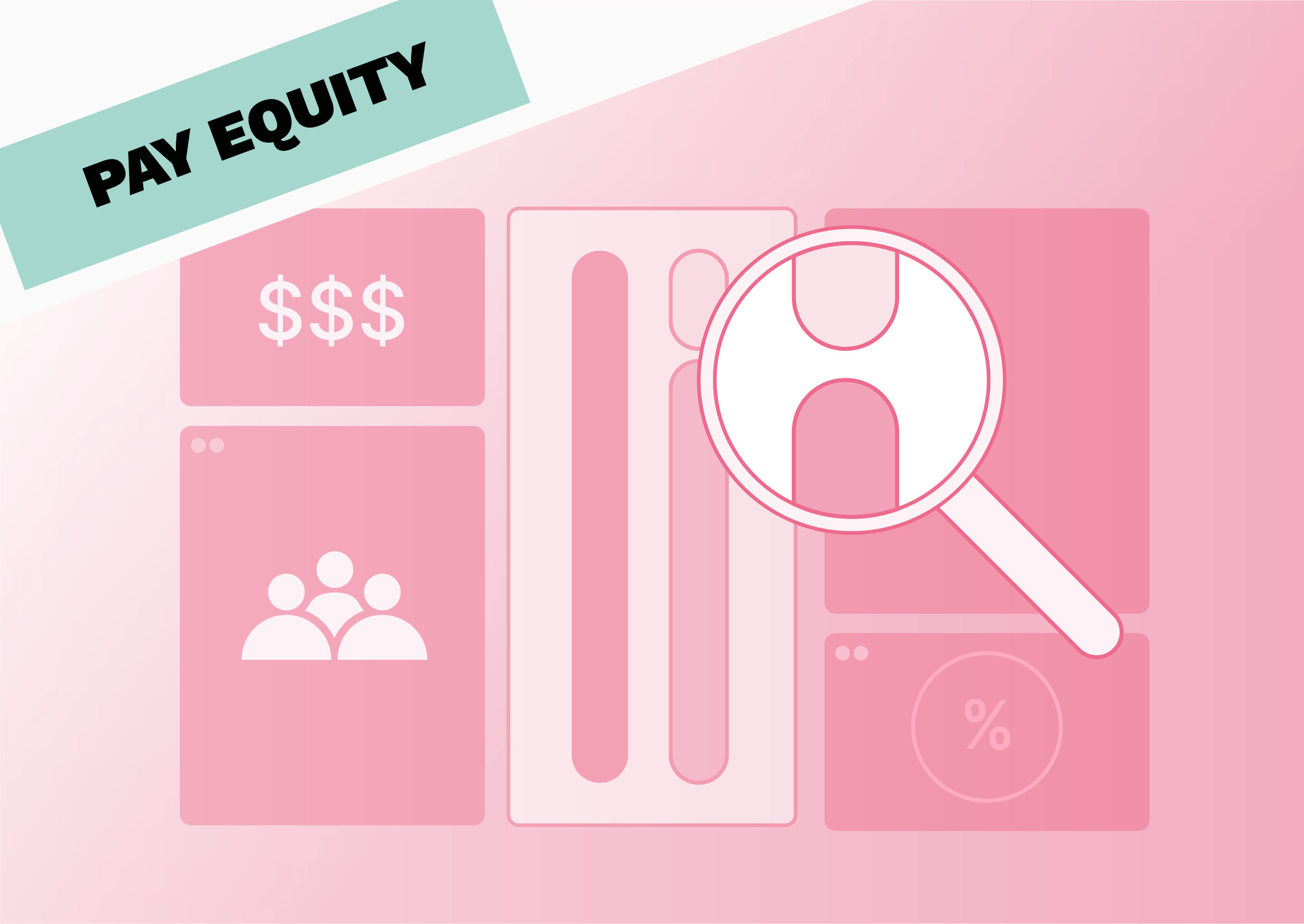Pay Equity vs Pay Equality: Differences Explained
As of November 2023, the gender pay gap in the UK is 14.3%. That means that, for every pound the average man earns, the average woman earns just 86p. And the situation is similar across much of Europe.
But… isn’t it illegal to pay women less than men for the same work?
Well, yes. In the UK, this is covered by the Equality Act 2010. And there’s similar legislation in other European countries.
But here’s the thing: the gender pay gap isn’t (just) caused by companies paying men and women different amounts for the same job (which, again, is illegal).
It’s driven by a whole number of different structural and societal factors. And to understand it, we need to distinguish between two key concepts: pay equity and pay equality.
Pay equity vs. pay equality: What’s the difference?
Pay equity and pay equality are two different concepts that are often confused with each other. Although they’re definitely related, they have different meanings — and it’s important to understand them if we want a chance at dismantling the gender pay gap.
What is pay equity?
Pay equity means that employees are paid the same amount if they perform the same or similar work. The term that’s often used in pay equity legislation (including the new EU pay transparency directive) is ‘equal pay for work of equal value’.
This means that, while there may be differences in pay due to things like performance, qualifications or tenure, employers can’t pay employees differently based on their gender, race, religion, sexual orientation or any other demographic characteristic.
What is pay equality?
Pay equality means that men and women are paid the same on average across an organisation (or a country). To be clear, this doesn’t mean that everyone gets the same salary. It means that the mean or median salary for a woman should be the same as the mean or median salary for a man.
This is a much more complex issue than pay equity, which is purely about compensation. Many of the factors standing in the way of true pay equality are systemic issues that will take a long time to dismantle.
Tying it to the gender pay gap: adjusted vs. unadjusted
Do you know the difference between your adjusted pay gap and your unadjusted pay gap? Here’s a quick refresher in case you need it:
- Your unadjusted gender pay gap is the overall difference in hourly pay between all men and all women across an organisation (or a country).
- Your adjusted gender pay gap is the difference in pay between men and women holding the same role at the same location.
In other words, a company’s adjusted pay gap is related to pay equity, whereas its unadjusted pay gap is more related to pay equality. While your adjusted gender pay gap is a pure compensation metric, your unadjusted pay gap is a bit more complicated.
There are a lot of reasons why women might earn less than men on average within an organisation, even if that organisation is committed to equitable pay.
For example:
- There are more men than women in the highest-paid job families and in management positions. This pushes up the average male salary compared to the average female salary.
- Job groups which have historically been filled by women, like nursing or childcare, tend to be lower paid than those typically filled by men, like building or construction.
- Women are disproportionately forced to leave the workforce to accommodate childcare and other unpaid obligations. This means they may have fewer years of experience than their male colleagues, even if they started work at the same time.
- Women are more likely to hold part-time roles than men, often because of their childcare obligations or other unpaid responsibilities. These roles tend to pay less per hour and come with fewer benefits than full-time positions.
When we talk about a country’s overall gender pay gap, we’re normally talking about the unadjusted pay gap. That means that tackling it isn’t just about raising women’s pay — it’s about providing equal opportunities for high-paid work to men and women alike.
What about other pay gaps?
So far, we’ve mostly talked about pay equity and equality through the lens of gender. This is because it’s a good entry point to the conversation and because it’s the focus of a lot of legislation around pay equity.
But it’s also important to note that there are a lot of different gender pay gaps too. For example, in the UK, Black, African, Caribbean or Black British employees consistently earn less on average than their white counterparts.
There are also pay gaps between people of different abilities, sexual orientations and socio-economic backgrounds — and all of these different pay gaps intersect with each other. For example, a disabled woman is likely to earn less than a non-disabled woman, who is in turn likely to earn less than a non-disabled man.
While you might start your journey towards pay equality by focusing on gender, it’s important to keep different characteristics in mind as you put the tips below into action.
Working towards pay equality: 4 steps to take
So, what can you do to work towards pay equality in your organisation? To begin with, ensuring your pay practices are equitable is a good place to start. If you’re not paying employees the same amount for the same work, there’s not much point in going any further.
But if you’ve dutifully calculated your adjusted gender pay gap and found that you’re all good there, there are a few more things you can do. Keep in mind that these are all long-term solutions that won’t necessarily make a difference overnight — but they will set you on the right path.
1. Rethink your recruitment strategy to attract diverse talent
The first step to ensuring women and minorities are paid as much as everyone else is getting them through the door in the first place. That means you need to rethink your entire recruitment process to make sure it’s set up to attract a diverse talent pool.
A good place to start is your job descriptions: studies have shown that ‘masculine’ wording can be offputting to female candidates, so you could be inadvertently limiting your talent pool if you’re not paying attention.
Beyond this, here are a few other things you can do:
- Put together diverse interview panels
- Use structured interview questions
- Avoid too much focus on ‘culture fit’
- Rethink your sourcing strategy to attract diverse talent
- Showcase your diversity through your employer brand
- Use blind resume screening (or even blind interviews)
2. Develop your junior talent (especially from underrepresented groups)
Women make up 48% of entry-level employees, but only 28% of the C-Suite. And the situation is even worse for women of colour. While these numbers have been growing steadily over the last few decades, they’re still not good enough if you’re aiming for true equality.
So, what can you do about it? The first step is to understand the extent of your problem. That means it’s a good idea to start tracking mobility within your company to find out who is being promoted (and who isn’t).
Once you’re armed with this information, you can start creating ‘talent escalators’ to propel employees from underrepresented groups into higher-level positions. For example, you could set up mentorship, job shadowing or employee development programmes specifically targeted at women or people of colour.
3. Offer benefits that support equitable participation and work-life balance
According to a PwC report, mothers experience a 60% drop in earnings compared to fathers in the decade after having their first child. Offering generous parental leave to both fathers and mothers can help to dismantle this ‘motherhood penalty’ by supporting new mothers’ transitions back into work, and allowing fathers to take on some of the burden of parenting.
We also shouldn’t forget that, as of 2023, women are still taking on the lion’s share of unpaid household tasks like cleaning, cooking and childcare. That means if you want to give your female employees an equal chance of progressing within your company, you need to make sure that the way you work works for them. For example, flexible working arrangements that allow parents to work around their childcare obligations can be invaluable to female employees.
4. Encourage the next generation of underrepresented talent
In certain industries, it can be a struggle to find diverse talent in the first place. That’s why forward-thinking companies must play a role in encouraging, inspiring and educating the next generation of workers.
For example, you could partner with schools, colleges and universities to create mentorship programmes, internships or scholarships for students from underrepresented groups. Attending career fairs, offering skills workshops and training sessions or getting involved with local community outreach programs are also great options.
The point is, with a bit of imagination, there are plenty of things you can do to introduce young people to fields they might not otherwise have come across. Ultimately, this can help you build tomorrow’s workforce — and make sure it gives everyone the same opportunity to thrive.
Learn more
Want to learn more about pay equity, pay equality and the EU directive? Check out these past articles from our archive:






